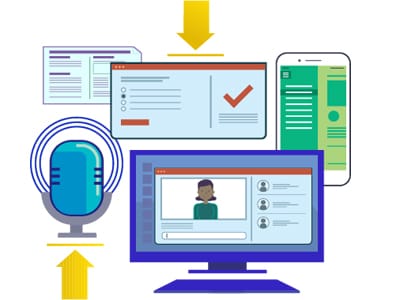CLOs and learning directors from all industries have achieved tremendous savings with blended learning. Understand the basics of blended learning, and you can, too.
What is blended learning?
By blended learning, we mean learning that comprises at least two different delivery media. Examples:
- Classroom training and online course
- Webinar, online course and on-the-job activities
- Webinar, video clips and peer coaching
- Online course and quick reference tools such as infographics, booklets, or apps
The delivery media can be incorporated into one event, or spread out over time (what we call “distributed blended learning”) for better reinforcement and retention. The case study below is an example of distributed blended learning.
When does blended learning make sense as a corporate learning strategy?
For a one-time training event or a course that is offered only once a year and requires heavy content updates each time, Instructor-led Training (ILT) led by a single expert can be very cost-effective. In most other instances, adopting a blended learning approach could save you significant money.
As with ILT, an initial investment of time and money is required to develop successful blended learning. With blended learning, after the initial development, the cost to deliver training drops off quickly and significantly.
Blended learning shines for courses that are delivered:
- Repeatedly
- To a large number of learners (especially if their time away from work is expensive)
- Over a wide geographic area
- By scarce/expensive instructors
It is especially helpful for:
- Training many people within a tight timeframe (e.g., to meet an IT implementation deadline)
- Capturing and spreading knowledge from sole experts (mitigates risk of losing that expert, and enables more people to perform support in the expert’s area)
- Training people who can’t be spared from their work for long periods at a time
- Leveraging the best training methods for each piece of content in a course
- Making content multi-purpose so it can be used during initial learning and as just-in-time (JIT) performance support
Where and how blended learning reduces corporate training costs
Blended learning saves companies money by reducing:
- Time away from work
Learners still need dedicated time for learning, just not as much because blended learning courses are typically significantly shorter than ILT courses. - Travel costs
Even if courses still have some face-to-face ILT components, shorter duration means lower hotel costs. - Ongoing instructor time
Up front development time may be higher than for ILT development, but ongoing delivery time plummets compared to ILT. Blended learning instructors often deliver some instruction, give feedback on assignments, moderate discussions, and answer learner questions—quite possibly for multiple courses simultaneously. - Facilities cost
Less classroom time means fewer facilities are needed. - Administrative support to coordinate travel
Administrative support for blended learning typically includes loading elements into the LMS (one-time, up front effort), plus communication and registration, which would also be needed for ILT courses. Templates for online communications make that part easier after the initial delivery.
In addition to the direct cost savings, companies also benefit from indirect savings related to:
- Lower employee turnover
Blended learning, when done right, engages learners and gives them performance support on the job. When learners feel the satisfaction and confidence of knowing how to do their jobs well, that can translate to staying longer with your company. - Improved performance
Using different media and targeting the content means learners learn and improve faster.
Target your blended learning to make it time- and cost-effective
Take advantage of these 2 major strategies to make blended learning fit for purpose for your learners, and time and cost savings will follow:
1. Prioritize The Content
With traditional ILT, experts often have a single chance to impart knowledge to learners, so they may try to teach everything about a topic rather than what the learner needs to know and master first. The results can be overwhelming for learners and ineffectual in performance.
With blended learning, the content can be prioritized and taught over time. Foundational/critical content can be taught first, and then learners can go back and apply it on the job. Less critical content can be offered in a subsequent course, or made available as Just-In-Time performance support. This improves learning retention, learner satisfaction, and performance.
2. Personalize Learning By Role
Blended learning enables delivery of content customized according to the learner’s role. In other words, a floor worker doesn’t have to sit through content that only applies to the floor supervisor, and vice versa. This can drastically reduce the time any one person spends in training, reduce confusion about what they’re responsible for learning, and increase their satisfaction and engagement.

A personalized learning map for each learner is a foundational communication and coordination tool. It can be as simple as a complete itinerary of all learning elements relevant to that learner (without the elements for other roles, or with such elements clearly marked as optional). It can be as sophisticated as a dynamic web page with links to all their personal elements, from webinar dial-in numbers to courses on the LMS to microlearning elements on a learning portal.
Especially when a blended learning course has many disparate elements, a personalized, clear, single access point eliminates uncertainty and makes the learner’s experience smooth and positive. Personalized learning maps boost progress and help learners feel engaged, empowered, and valued.
Case study
One of our clients had a flagship, highly technical, two-week ILT course, delivered in two five-day sessions. They always booked the program with 12 local learners and 12 flying in. Conservatively, the travel cost would be $1,000 round-trip flight + $1,500 hotel = $2,500 per person × 12 flyers × 2 sessions = $60,000 plus food, every single time they taught the course.
For the client in this case study, we redesigned the program using a distributed blended learning model. The two-week bootcamp became:
- An orientation webinar plus WBTs about the equipment (pre-work)
- A two-day Thursday/Friday onsite course (core discovery learning)
- An online community and work-based assignments for ongoing networking and problem-solving (performance support)
Cost reduction:
- Learner time spent in training was reduced from 10 work days to 12-15 hours for the core training, plus self-paced pre- and post-work.
- Travel cost was reduced to one-third of the original costs (estimated at $20,000 vs. $60,000 per course).
Better learning outcomes at a fraction of the ongoing cost for delivery—this is a win for employees and your bottom line, and it’s why leaders across industries are choosing blended learning as their corporate learning strategy.







